Adrian Collins's Blog, page 69
January 17, 2024
REVIEW: The Folly by Gemma Amor
The Folly is Gemma Amor’s brooding Gothic mystery that evokes the best of both Daphne du Maurier’s Rebecca and Ann Radcliffe’s The Mysteries of Udolpho.
 The Folly opens with forty-three-year-old Morgan as she retrieves her father from prison. Morgan’s father was sentenced in a high-profile trial for the murder of his wife but is now being released following an appeal and eventual retrial. The isolation of prison is replaced by the disquieting loneliness of the COVID-19 pandemic:
The Folly opens with forty-three-year-old Morgan as she retrieves her father from prison. Morgan’s father was sentenced in a high-profile trial for the murder of his wife but is now being released following an appeal and eventual retrial. The isolation of prison is replaced by the disquieting loneliness of the COVID-19 pandemic:
“What a life, I thought, in which every basic human need had become a protracted operation. Grocery shopping, doctor appointments, dentist appointments, haircuts, all the everyday shit we’d taken for granted suddenly layered with anxious complexity. What a world for Dad to come out into, after everything he suffered already.”
Financial strain and the unbearable memories of her mother’s death lead Morgan to sell their family home in Bristol and build a new life along the Cornwall coast. Morgan and her father become caretakers of the Folly, a gloomy lighthouse-style tower famous for its death tourists, whose visits to the Folly are destined to be their last.
“A decorative, brooding, and yet wholly frivolous endeavour, the Folly was a tall black granite tower with distinct crenellations capping the roof. It sat stoically on the very tip of a craggy, hooked peninsula, rising confidently above the sea as if it belonged to another era, as if ancient kings had resided there once.”
Gemma Amor channels Daphne du Maurier’s dark, poetic writing style, perfectly capturing the atmosphere and tone of Rebecca. Like du Maurier, Amor explores themes of personal identity and isolation, while slowly revealing hidden secrets and motivations.
This wouldn’t be a Gemma Amor novel without a healthy dose of horror. Amor strikes just the right level of supernatural dread to make The Folly feel deeply unsettling but without ever becoming excessive.
Following up on her back-to-back masterpieces, Full Immersion and The Once Yellow House, the Bram Stoker and British Fantasy Award nominated author Gemma Amor apparently can do no wrong. Although less ambitious in scope than her previous two novels, The Folly is an understated Gothic gem from one of today’s most exhilarating voices in speculative fiction.
Read The Folly by Gemma AmorAmazon (US Hardcover)Amazon (US Audiobook)Amazon (UK Hardcover)Amazon (UK Audiobook)The post REVIEW: The Folly by Gemma Amor appeared first on Grimdark Magazine.
January 16, 2024
REVIEW: Overdue by Mark Lawrence
Inspiration cuts across space and time in “Overdue,” Mark Lawrence’s first short story from his Library Trilogy. The main action in “Overdue” takes place in independent bookshops, focusing on the store owners’ love of literature and their relative isolation from society.
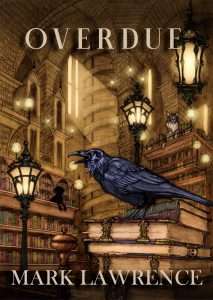 All bookstores need a cat, and “Overdue” opens with Wentworth, the feline of unusual size from The Book That Wouldn’t Burn. Wentworth is based on Mark Lawrence’s own cat, Wobble, a Maine Coon who may intimidate even the fiercest mountain lion. “Overdue” also has guest appearances by two other animal friends from The Book That Wouldn’t Burn: the pitch-black dog, Volente, and the raven whose name I shall not reveal.
All bookstores need a cat, and “Overdue” opens with Wentworth, the feline of unusual size from The Book That Wouldn’t Burn. Wentworth is based on Mark Lawrence’s own cat, Wobble, a Maine Coon who may intimidate even the fiercest mountain lion. “Overdue” also has guest appearances by two other animal friends from The Book That Wouldn’t Burn: the pitch-black dog, Volente, and the raven whose name I shall not reveal.
Mark Lawrence blew away my expectations with “Overdue.” I expected “Overdue” to be a simple story about an oversized cat going on an adventure. But “Overdue” is so much more: it’s a touching tale full of nuance and emotion, and one of Mark Lawrence’s best short stories to date. I previously published a listicle of Top Ten Mark Lawrence Short Stories, and “Overdue” would easily fall within the top five on that list.
The plot is more complex than I had anticipated, as Mark Lawrence constructs a circle of literary influence that transcends geographical and temporal boundaries. The interwoven nature of the tale beautifully conveys how aspiring authors can discover inspiration in the most unlikely sources. I particularly enjoyed the unexpected symmetry of inspiration presented in “Overdue,” which left a great emotional impact on par with Lawrence’s best stories.
Although “Overdue” is set in the same universe as the Library Trilogy, it’s not strictly necessary to read The Book That Wouldn’t Burn before picking up this short story. There are no spoilers here that would lessen your enjoyment of The Book That Wouldn’t Burn, and other than the trio of animal friends, there is only one overlapping character: the kindly and enigmatic librarian, Yute. All the other characters are self-contained within the short story. Hence, “Overdue” can be enjoyed as a standalone tale, although readers who are already familiar with The Book That Wouldn’t Burn will appreciate many subtle and not-so-subtle references made within this short story.
A deep love of literature connects us all in the bookish community, a bond that manifests poignantly in “Overdue” as Wentworth helps lonely booklovers find both inspiration and companionship. “Overdue” is an ode to the power of literature which binds us together. This short story is a must-read for fans of The Book That Wouldn’t Burn and highly recommended for anyone who shares Mark Lawrence’s passion for the written word.
Read Overdue by Mark LawrenceAmazon USAmazon UKThe post REVIEW: Overdue by Mark Lawrence appeared first on Grimdark Magazine.
The Library Trilogy, The Hag, and AI’s impact on publishing – an interview with Mark Lawrence
Last Updated on January 17, 2024
From Prince of Thorns being loved by grimdark fans, to giving Grimdark Magazine our very first ever cover story with Bad Seed, to those absolutely stunning special editions for The Book that Wouldn’t Burn, Mark Lawrence is a fan favourite. This week, John and I got to spend an hour speaking with Mark about The Library Trilogy (trilogy), his new upcoming dark fantasy / grimdark fantasy trilogy tentatively titled The Hag, SPFBO, AI‘s impact on publishing, why he likes writing short stories but prefers reading novels, and a potential future short story collection.
The post The Library Trilogy, The Hag, and AI’s impact on publishing – an interview with Mark Lawrence appeared first on Grimdark Magazine.
January 15, 2024
REVIEW: A Lion’s Pride by P.L. Stuart
A Lion’s Pride is the fourth volume in P.L. Stuart’s Drowned Kingdom Saga, which is inspired by the mythology of Atlantis. The events of Book Four are destined to change everything for our protagonist, Othrun, the former prince of a sunken island kingdom who has established a new realm on foreign soil. I will keep this review completely spoiler-free for readers who have not yet started this excellent grimdark fantasy series, which began with A Drowned Kingdom and continued with The Last of the Atalanteans and Lord and King.
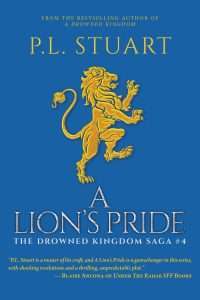 A Lion’s Pride introduces a new point-of-view character, Rupaa, a feared pirate and warrior who offers a third-person perspective from another culture. Although I am inherently resistant to the incorporation of new point-of-view characters this late in a series, P.L. Stuart ensures that the investment pays off well with an earthshattering reveal later in the book.
A Lion’s Pride introduces a new point-of-view character, Rupaa, a feared pirate and warrior who offers a third-person perspective from another culture. Although I am inherently resistant to the incorporation of new point-of-view characters this late in a series, P.L. Stuart ensures that the investment pays off well with an earthshattering reveal later in the book.
Soon we are back in familiar territory with Othrun’s first-person narration, where we spend the vast majority of the novel. No worries if it’s been a while since you’ve read Lord and King: P.L. Stuart naturally immerses the reader back into the story, catching us up on key events from the first three volumes.
I’m not sure if the seven volumes of the Drowned Kingdom Saga are meant to align with the Seven Deadly Sins, but if they did, Book Four would certainly be dedicated to lust. A Lion’s Pride is a spicy book, with Othrun pursuing several romantic entanglements against his better judgment.
Othrun is a walking contradiction: nominally a prude but unable to resist temptations of the flesh. Despite his own misogynistic views, Othrun seems inevitably drawn to strong, independent women. However, I think the more interesting question is why these women—all possessing powerful magic—would be attracted to a man who is so condescending toward them.
With this heavy focus on Othrun’s lustful pursuits, A Lion’s Pride feels a bit off balance compared to the previous volumes of the series, especially since Othrun’s dalliances are described in explicit detail, too much for my own tastes. Fortunately, these plot lines are interwoven with plenty of political intrigue as well as questions about Othrun’s lineage and claim to the throne.
Given all this court intrigue, A Lion’s Pride feels like the most Arthurian installment yet in P.L. Stuart’s series, with Lysi playing the role of the seductress witch, Morgan le Fay. With his penchant for self-sabotage and internal contradictions, Othrun embodies the dual role of both Arthur and Lancelot.
Religion continues to be a dominant theme throughout A Lion’s Pride, with Othrun believing he is on a divine mission to convert pagans of his adopted land to the monotheistic beliefs of his Single God. Othrun’s religious intolerance is on full display throughout the novel. The cultural clashes and political maneuverings eventually culminate in an epic battle scene toward the end of the book, which had me on the edge of my seat.
Although Othrun is a despicable and frustrating character, I do believe he is on a slow redemption arc. One of P.L. Stuart’s overarching themes is the power of redemption: anyone can change for the better, even those who seem beyond hope.
Overall, A Lion’s Pride cements Othrun as one of the most complex and well-realized grimdark protagonists in recent memory. P.L. Stuart has certainly earned his stripes as one of Grimdark Magazine’s Rising Stars in Dark and Grimdark SFF. The Drowned Kingdom Saga will continue with A Pack of Wolves, the fifth book of Stuart’s planned seven-book series.
Read A Lion’s Pride by P.L. StuartAmazon USAmazon UKThe post REVIEW: A Lion’s Pride by P.L. Stuart appeared first on Grimdark Magazine.
January 14, 2024
REVIEW: Vampire: The masquerade: Swansong
Vampire: The masquerade: Swansong is a very difficult game to review and is basically a heart monitor when it comes to quality. There are parts that are magnificent with incredibly good writing, world-building, and character interactions. Finding these parts of the game requires you to read large chunks of the in-game codex and use of a guide since there’s no indication you should be looking for these parts. Plus, there’s parts of the game that are just outright broken and deeply frustrating if you want to have a functional experience.
Swansong is a detective game set in the World of Darkness, specifically Vampire: The Masquerade setting. It is not Bloodlines or anything like Bloodlines but closer to something like Monkey Island or other adventure game. You go around having conversations with people, picking up objects, and trying to figure out puzzles to figure out what goes where to achieve what.
You play three separate vampire characters: lesbian Toreador artist Emem, tortured Malkavian prophetess Leysha, and brooding Ventrue elder Galeb. All three of them were supposed to attend a party signalling the alliance of the Boston Camarilla (the vampire mafia for newbies) with the Hartford Tremere chantry (vampire wizards). However, something happened at the party, and now a bunch of Kindred may or may not be dead. It’s up to to you to find out what happened and play the political games that are central to the existence of Kindred.
I admit the game made a poor first impression with me by the fact that after twenty minutes of introduction, I ended up getting stuck in a door and the game saving its one save file so that I permanently stuck in it. I had to start the game over. Which wouldn’t have been a problem if not for the fact that not much past that point on my restart, it happened to me again after falling through the floor. I was ready to quit the game after that and with good reason. Still, I persevered on and started having a lot of fun. The restarting element didn’t need to happen but a couple of more times and became less of a problem when I had access to the levels I’d previously cleared.
The positives first, when the game gets going, it certainly does get what V:TM is all about. It’s about long established relationships and rivalries between immortal beings. The best parts of the game are when the player characters are leaning heavily into their personal struggles with their sire, past wrongs, and ancient rivalries. Emem used to be in a relationship with their sire but broke it off after an incident involving a forcible blood bond. Leysha’s “doctor” is a crooked scientist experimenting on blood as well as her. Galeb hates his eldest childe and is hoping to find redemption with his latest prospect.
This is the way a V:TM game should be written and designed with the idea of you just mostly wandering around and interacying with people. The most important skills in the game are your Persuasion, Education, Technology, and other social skills instead of your Disciplines. The game also continues if your character dies and I appreciate that kind of permanency when making a story.
Of the three main characters, I had to say I liked Galeb the most. Emem has some great moments and her backstory is great (assuming you get to see it) and Leysha is a Malkavian seer so an automatic win but Galeb really embodies the kind of old school Ventrue leader that actually earned the title of Prince. There’s some really good levels to go with the more mediocre ones too like when you explore a human accountant’s apartment for clues as well as infiltrate the Second Inquisition’s local base. My favorite level is probably when Leysha visits the party and we find out what happened to all the Kindred there.
Unfortunately, the bad parts of the game are deeply counter-intuitive. There’s a level where your character has their memory erased and you get a huge amount of backstory on their personality, goals, and relationships by recovering the fragments. However, the game never tells you that you’re missing your memories so you only stumble on them by accident. They also are all different looking objects so you just have to constantly touch everything as well as stick your hands into nook or cranny to get an essential part of the story.
My conclusion is that Swansong is a good game, on PC and not so much console. Furthermore, I think this is a rare game where you should just cheat the hell out of it. Read a guide for instructions on what to do each level and you’ll enjoy it more than if you tried to figure it out. I rarely say that but you’re missing tons of story if you just do what the game tells you to do so. The game would have also massively benefited from the ability to save as you will because you could do a lot more exploring that way as well as check out different outcomes.
The post REVIEW: Vampire: The masquerade: Swansong appeared first on Grimdark Magazine.
January 13, 2024
REVIEW: Pillar of Ash by H.M. Long
Pillar of Ash by H.M. Long is the fourth and final part of her The Four Pillars series. The novel is preceded in the series by Hall of Smoke and Bone, Temple of No God, and Barrow of Winter. Although Long has set these four novels in the same world, each has its own focus and main character. I would recommend reading the series in chronological order to understand Long’s vivid world entirely, but you probably would not need to reread them before starting Pillar of Ash to appreciate this novel in its own right. This is by no means essential; any relevant prior events are explained as part of Long’s prose and are then directly linked to the events of this particular narrative. In Pillar of Ash, Long nimbly links the longer plot threads from the previous three novels and concludes this epic fantasy series satisfactorily. If you have not already started The Four Pillars series, I recommend it especially if you are a fan of authors such as Rebecca Ross or Kell Woods or fancy an escape to a richly developed fantasy world safe in the knowledge that this arc is complete.
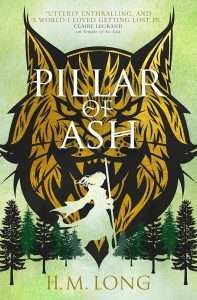 As with the other novels in this series, Long’s main character in Pillar of Ash is a woman. In this instance, we follow the journey of Yske, a healer from Eangen. Unlike the warrior women Hessa (Yske’s mother) and Thray (her cousin) whose stories we chartered in the earlier novels, Yske is a pacifist and a healer. This choice marks her as different from her people, and Yske is a sort of social outcast, not understood by any of her family or able to form proper friendships. She dedicates her life to her vocation and leads a largely solitary existence until her twin brother, Berin, decides upon a quest for glory and adventure. He asks her to join him and his group as their healer while they travel to the distant Eastern lands. This perilous journey will test Yske in ways she has never been before, both as a person and a healer. Eventually, she finds herself at the heart of something she never wished to be involved with – a battle where the stakes are higher than she could ever imagine.
As with the other novels in this series, Long’s main character in Pillar of Ash is a woman. In this instance, we follow the journey of Yske, a healer from Eangen. Unlike the warrior women Hessa (Yske’s mother) and Thray (her cousin) whose stories we chartered in the earlier novels, Yske is a pacifist and a healer. This choice marks her as different from her people, and Yske is a sort of social outcast, not understood by any of her family or able to form proper friendships. She dedicates her life to her vocation and leads a largely solitary existence until her twin brother, Berin, decides upon a quest for glory and adventure. He asks her to join him and his group as their healer while they travel to the distant Eastern lands. This perilous journey will test Yske in ways she has never been before, both as a person and a healer. Eventually, she finds herself at the heart of something she never wished to be involved with – a battle where the stakes are higher than she could ever imagine.
I love Long’s writing style. It is vibrant and engaging without ever being dense or overwhelming. Each novel in The Four Pillars covers a different area of her vast world, so although some characters are familiar, nothing seems repetitive. Pillar of Ash simultaneously feels fresh because we are following a new protagonist and the ease of being in a world we know, even if the location for this novel is eerie and unsettling. However, of the three lead women in Long’s saga, Yske is the closest the reader gets to a damsel in distress, and at times I found her to be quite frustrating. Her pacifism is admirable, but on a journey littered with danger, it makes her a liability and risks those around her. Other characters shared my frustration, and for a time, Yske was more isolated than ever. Long never allows this frustration to fester and make Yske unlikeable, but I found her to be the least compelling of the novel leads in the series.
Pillar of Ash is a novel of adventure. There are some times of peace and some of the peril. Yske’s tentative romance does not overtake the plot or overshadow her relationships with her family and traveling companions. My favourite in the series remains the third novel, Barrow of Winter, but Pillar of Ash was an enjoyable read and a worthy conclusion to Long’s series. All the books from The Four Pillars Series are available from Titan Books. Thank you to both H.M. Long and the team at Titan Books for sending me an advanced reader copy of Pillar of Ash so I can provide this review.
Read Pillar of Ash by H.M. LongAmazon (US Paperback)Amazon (US Audiobook)Amazon (UK Paperback)Amazon (UK Audiobook)The post REVIEW: Pillar of Ash by H.M. Long appeared first on Grimdark Magazine.
January 12, 2024
REVIEW: Creepshow #4
The premier comic for short, sharp and satisfyingly horrific stories returns with Creepshow #4. The opening story, “Killer Cart Corral,” delivers its thrills, spills and chills in satisfyingly gruesome tones as writer Nick Dragotta writes and co-illustrates a story that will give you Big Box Fever!
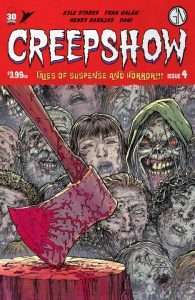 Billy is the apple of his mother’s distracted eye. He’s proud to take the plaudits of her affection, just as he’s proud to ram a shopping cart into a deluxe car in the big box parking lot down at his local mall while cackling like a madman. Billy thought he was a bad seed…except, he’s about to confront someone far far badder than he.
Billy is the apple of his mother’s distracted eye. He’s proud to take the plaudits of her affection, just as he’s proud to ram a shopping cart into a deluxe car in the big box parking lot down at his local mall while cackling like a madman. Billy thought he was a bad seed…except, he’s about to confront someone far far badder than he.
So when Billy’s mom confronts the manager of the store, bespectacled Mrs Cartwright, she not only faces an indomitable woman intent on ensuring her store runs along, shall we say, extremely terminal lines, but also the truth about her bright eyed Billy. Billy has been a very, very naughty boy, and under the merciless glare of the security cameras, his serial naughtiness is exposed for all to see. Shoplifting and drug dealing in store to his fellow students marks Billy as one out of the (big) box. But now, his time of reckoning has arrived…
Dragotta and the other illustrator, Jean-Francis Beaulieu, don’t flinch as they illustrate this satisfyingly nasty little morality tale. We are all grist for Capitalism’s mill, none more so than those who dare seek to thumb their noses at it. There is a definitely delightful snap, crackle and pop feel to the end of the story, as bones break and blood spurts as a reckoning crash lands on Billy’s mom at her terminal cost. Her gurgled final words demonstrate the Creepshow ethos – gory fun for all!
Creepshow #4 concludes with a fine little story called “The Amulet.” We’re all going to get old, right, unless, you know, an uncaring universe intervenes at an unfortunately early age. Still, our family loves us, right. Right? They might shove us oldsters into a state of the art retirement village, where the staff will treat us with the respect our golden years demand, and where the food we’re asked to eat isn’t a bizarre combination of applesauce and the cooked remains of our peers.
Oh dear. We are in trouble. However, new resident, retired archaeologist and sometime witch, Professor Alvina Madigan has just the thing to ward off the hammer wielding manager – the titular Amulet!
“The Amulet” is a fun little tale that does labour at some points, but still ends in a satisfyingly spooky manner in a soul swapping story that hits all the right buttons. Mauricet’s clean artwork evokes a world as neat as a pin, laid over a dark, dark heart devoted to elder abuse, theft and dare I say it, cannibalism! Overall, though, the reader is left feeling a sense of (misplaced?) triumph as the satanic Professor embarks on her new life.
Special shoutout in this review goes to cover artist for Creepshow #4, Guillem March, whose truly gnarly puppet show is one that sears itself onto your retinas and will stay with you forever. Less The Muppets and more The Feebles!
Read Creepshow #4Amazon USAmazon UKThe post REVIEW: Creepshow #4 appeared first on Grimdark Magazine.
January 11, 2024
REVIEW: The Exile of Zanzibar by Daniel Maidman
The Exile of Zanzibar is Daniel Maidman’s debut fantasy novel set in a fictional version of Florence during the Bronze Age. King Ambrosius the Ninth of Florence wages war with the neighboring city of Genova as a mysterious woman appears in a glowing gold palanquin.
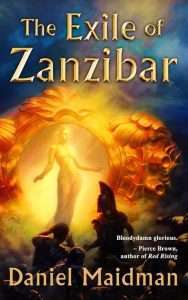 The visitor is Claire, a “patricia of Zanzibar” and student of metaphysics who has constructed a device that folds space and time. But everything goes wrong when she finds herself in the middle of a faraway war zone. Claire desperately wants to return to her home of Zanzibar:
The visitor is Claire, a “patricia of Zanzibar” and student of metaphysics who has constructed a device that folds space and time. But everything goes wrong when she finds herself in the middle of a faraway war zone. Claire desperately wants to return to her home of Zanzibar:
“I am the last daughter Reason bore; I rose from Zanzibar and to Zanzibar I must return.”
Claire recognizes that she needs help from the local populace if she has any hope of returning home. She befriends Marcus Diophantus, a Florentine city man and former pickpocket who rises to become a respected military leader. Claire and Marcus work together to forge peace between Florence and Genova.
Marcus also develops a romantic interest in Claire, who becomes known as the “Sower of Peace.” The relationship between these two characters is the emotional core of the novel. But the Sower of Peace becomes entangled in a web of political intrigue amid the changing power dynamics prompted by her wartime intervention.
The author, Daniel Maidman, is also an artist and an art critic. His art is included in several American art museums and is part of the permanent collections at the Library of Congress Department of Prints and Drawings. Maidman brings his artistic talent to The Exile of Zanzibar with his gorgeous interior artwork, depicting several characters and scenes from the novel. While the writing could feel a bit academic at times, I found that the artwork helped establish a stronger emotional connection with the characters.
Although The Exile of Zanzibar is available as an electronic book, I’d strongly recommend investing in a hardcover copy of this novel. From the exquisite artwork to the minute details of the font kerning, Daniel Maidman has paid keen attention to every aspect of this volume.
Daniel Maidman’s writing is erudite but accessible, reminding me of the late Italian master, . There is a gravity to Maidman’s prose that has a feel of ancient history brought to life. Maidman obviously shares Eco’s love of history and philosophy, constructing a sophisticated, labyrinthine plot worthy of Foucault’s Pendulum. Although it’s not mentioned in his biography, I wouldn’t be surprised if Daniel Maidman is also a scholar of semiotics: the detailed attention that he pays to symbols and colors throughout The Exile of Zanzibar also echoes the great Eco.
The worldbuilding of The Exile of Zanzibar is essentially classical antiquity with a splash of magic and sci-fi. There is a strong military fantasy aspect of the novel, and grimdark readers will appreciate the layers of gray morality that Daniel Maidman has woven into the political fabric of the story.
Overall, The Exile of Zanzibar is a meticulously crafted debut and a must-read for fans of Umberto Eco. The story will continue with Lucky Angel, the second volume of the Railroad to Zanzibar series.
Read The Exile of Zanzibar by Daniel MaidmanAmazon (US Hardcover)Amazon (US Paperback)Amazon (UK Hardcover)Amazon (UK Paperback)The post REVIEW: The Exile of Zanzibar by Daniel Maidman appeared first on Grimdark Magazine.
January 10, 2024
REVIEW: The Last Bloodcarver by Vanessa Le
Vanessa Le’s The Last Bloodcarver is a Vietnamese-influenced YA fantasy. Set in a world in which rare blood magic allows wielders to heal, they are ostracised and hunted for their power. The fear of power being used to hurt others prevents their open use to help and save others. It looks at the shifting relationships between power and powerlessness, and how both of these states may apply simultaneously.
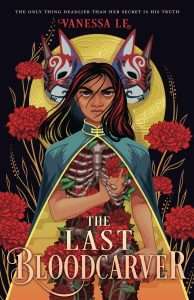 Nhika grows up an outcast, unable to share the truth of herself with the people around her. We meet her when she is claimed by Mimi and Andao, siblings due to inherit a fortune through their father. He was murdered and the only person who might give the siblings closure is in a comatose state after the attack – so when they figured out what Nhika is, it seemed serendipitous. They offer her a home, and in exchange she uses her Bloodcarver magic in their service. But matters are complicated by the suspicious Dr Santo and his pesky assistant, Kochin. Will Nhika find a way to navigate through this maze of threats and expectations?
Nhika grows up an outcast, unable to share the truth of herself with the people around her. We meet her when she is claimed by Mimi and Andao, siblings due to inherit a fortune through their father. He was murdered and the only person who might give the siblings closure is in a comatose state after the attack – so when they figured out what Nhika is, it seemed serendipitous. They offer her a home, and in exchange she uses her Bloodcarver magic in their service. But matters are complicated by the suspicious Dr Santo and his pesky assistant, Kochin. Will Nhika find a way to navigate through this maze of threats and expectations?
Theumas is a hostile environment for the characters, a place in which science and magic intersect but only one is embraced. In The Last Bloodcarver, that conflict is even more present for Nhika than for many others. Mimi and Andao are heirs to a pharmaceutical empire, and Dr Santo, the physician attending their family, was a close associate of her father’s. Intelligent and full of knowledge and experience in medicine, he soon figures out what Nhika is. And anyone who knows her secret is a threat, given the general sentiment towards Bloodcarver magic in Theumas. How far are you willing to go to protect you and yours? This is the central question in The Last Bloodcarver, acting as a catalyst for the story to unfold.
The pacing is tight and full of narrative tension. The Last Bloodcarver is a book to be devoured, to be raced through. The plot and character relationships keep the reader fixed to the page, wondering what will come next. This is a young adult novel, though one with great appeal to the Grimdark Audience. Characters act in utterly selfish ways, wading through the sea of grey morality. None of them can be considered good or morally upstanding, which we love. There is a romantic element to the story – an arc that is well-developed, though does not take centre stage. And then, Le nails The Last Bloodcarver’s ending. A debut and debut author to look out for – The Last Bloodcarver is unique and thrilling, bound to make a splash when it releases.
Read The Last Bloodcarver by Vanessa LeHardcover USAudible USPaperback UKKindle UKThe post REVIEW: The Last Bloodcarver by Vanessa Le appeared first on Grimdark Magazine.
January 9, 2024
REVIEW: Grievar’s Blood by Alexander Darwin
Last Updated on January 10, 2024
Grievar’s Blood is the second installment in Alexander Darwin’s Combat Codes trilogy, following up on his debut novel, The Combat Codes. The Combat Codes trilogy takes place in a post-apocalyptic world where conventional warfare has been replaced by hand-to-hand combat between trained fighters known as Grievar Knights who spar on behalf of their nations. Given their critical importance to national interests, Grievar Knights receive the highest levels of training at special martial arts schools. However, some nefarious entities try to cheat the system by enhancing fighters through technology or other illicit means.
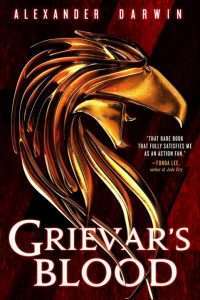 The main protagonist of the Combat Codes trilogy is Cego, a diamond-in-the-rough boy who demonstrated great promise as a fighter in underground arenas. In The Combat Codes, Cego is discovered by Murray Pearson, a retired Grievar Knight with a troubled past, who assumes personal mentorship of Cego, training him to become the next champion fighter for their nation of Ezo.
The main protagonist of the Combat Codes trilogy is Cego, a diamond-in-the-rough boy who demonstrated great promise as a fighter in underground arenas. In The Combat Codes, Cego is discovered by Murray Pearson, a retired Grievar Knight with a troubled past, who assumes personal mentorship of Cego, training him to become the next champion fighter for their nation of Ezo.
Much of the action of the series takes place in the Lyceum, a training school where students both native and foreign are taught to pursue excellence in martial arts, following the greater purpose of the Combat Codes, viz., avoiding war and helping their country. However, the Combat Codes might also serve as a means to control and suppress people.
The first book of the trilogy, The Combat Codes, was a case of mismatched expectations for me personally. Based on the book’s description and dragon image on the cover, I was expecting the novel to be similar to Mortal Kombat in terms of its storyline and action. However, I found The Combat Codes to be much closer in spirit to The Karate Kid, with Murray Pearson playing the role of sensei and Cego serving as his protégé. Much of the book was dedicated to the psychological and philosophical aspects of martial arts and the importance of never sacrificing one’s honor. The Combat Codes also embraced many of the standard training school tropes from young adult fantasy literature, such as making friends and dealing with bullies. As a grimdark reader, The Combat Codes left me wanting something darker and more intense.
I’m happy to report that Alexander Darwin gives a deeper and more mature spin on the story in Grievar’s Blood, which picks up a year or so after the events of The Combat Codes. In this second book of the series, Darwin divides point-of-view duties among three protagonists: Cego, Murray, and Cego’s good friend, Solara Halberd, or Sol for short. Sol’s storyline is a welcome addition to the book, both for improving female representation in the series and for all the raw excitement that she brings to the novel.
Alexander Darwin has also matured as a writer in his sophomore effort. The characters feel more fully formed in Grievar’s Blood, and the book definitely has a more nuanced tone. There are plenty of unexpected plot twists in Grievar’s Blood, and the last page had a revelation that left me hungry to find out what happens next.
The epic fight scenes are a thrill to read, with well-earned comparisons to Fonda Lee’s Jade City. Like Fonda Lee, Alexander Darwin is an accomplished martial arts master who leverages that personal experience to write very well-crafted, cinematic fight sequences. Another point of similarity is the inclusion of rocs in Grievar’s Blood, which are also the main focus of Fonda Lee’s recent novella, Untethered Sky.
Overall, Alexandar Darwin has given grimdark readers a lot more to enjoy in Grievar’s Blood, with higher stakes, darker action, and a more epic scope. The Combat Codes trilogy is certainly a must-read for martial arts enthusiasts.
Read Grievar’s Blood by Alexander DarwinAmazon (US Paperback)Amazon (US Audiobook)Amazon (UK Paperback)The post REVIEW: Grievar’s Blood by Alexander Darwin appeared first on Grimdark Magazine.



